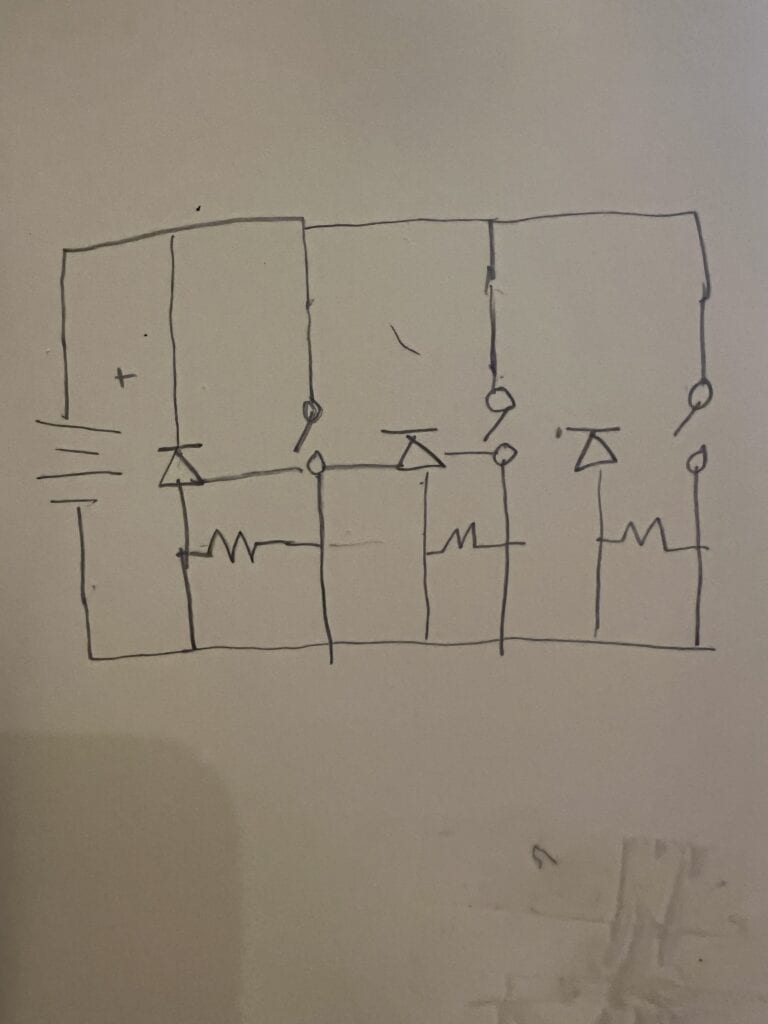Reflection
Q1: What is the function of the resistor R1?
Resistors resist, but don’t completely, block the flow of electricity. How much current flows through a circuit depends on how conductive the circuit is. A circuit with higher resistance would let less of a current flow through. A resistor can help prevent something sensitive to high current, like an LED, from exploding. Because we have two circuit paths here, with two LEDs, a potentiometer can help divide the current, or decrease the output voltage can help . The resistor also allows the button to “pull up” and “pull down.”
Q2: Looking at the following circuit, draw its diagram by yourself.

Q3: After reading ‘The Art of Interactive Design,’ in what way do you think that the circuit you built today includes interactivity? Which degree of interactivity does it possess? Please explain.
This excerpt was very interesting and answered the questions the author rose for themselves and the questions I thought for myself as I kept reading. Initially, I was prepared to answer “yes” to the question of whether or not the circuit system we built was interactive. We (my partner and I) are certainly using our motor functions to interact with the device (pressing the button), which has a visible (light flashing) and auditory (buzzer sounding) result. But how long did it capture our attention? We definitely felt successful and relieved when the buzzer sounded as it should and LED lit up as it should. But, like the author questioned, how long would the average adult sit there and press the button repeatedly to see the result? What about a child? Changing to the switch paddle perhaps kept us entertained for a little while longer, and felt more truly “interactive.”
This raised a question about attention for me as well. I believe attention is something you inherently have to consider–if you are unable to capture the attention of a potential user, who will use your product? If you can’t preserve their attention, how will you maintain longevity of use? The circuit worked as it should, but is it good design?
Evaluating our product using the language put forward by the author, I think our circuit possessed a low degree of interactivity. The line that caught my attention was that an interaction like opening a fridge door is “silly and beneath the intellectual dignity of almost everybody” (Crawford, 4). It, for likely the majority of people, is an unremarkable interaction.
Q4: How can Interaction Design and Physical Computing be used to create Interactive Art? You can reference Zack Lieberman’s video or any other artists that you know.
I believe I know many people in my life that either don’t enjoy or don’t even consider going to museums, art galleries, or showcases. They know that when they do go, they will just stand and look. I think streamlined personal technology has conditioned us to expect interaction in everything, and extremely accessible, portable, and free interaction at that. Physical computing and interaction design has the capability of attracting these people, or it may even need to provide a solution to a longevity problem of some art forms. Success has been seen in forms such as installation art, but I find it interesting to think about how in some forms, such as VR, people seem to be more and more uneasy with it. The “art” aspect is sometimes lost in absorbing the technology side of it, which often produces a longing for the traditional.

